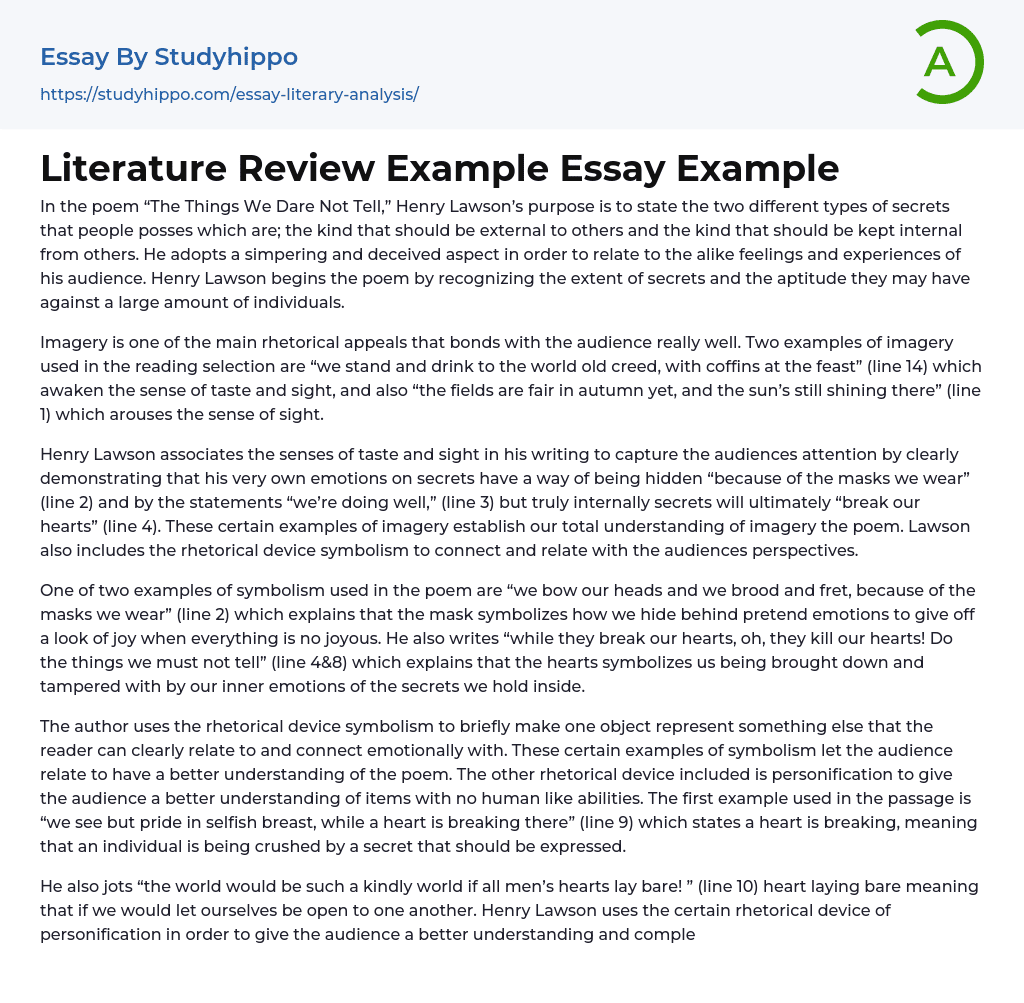In the poem “The Things We Dare Not Tell,” Henry Lawson’s purpose is to state the two different types of secrets that people posses which are; the kind that should be external to others and the kind that should be kept internal from others. He adopts a simpering and deceived aspect in order to relate to the alike feelings and experiences of his audience. Henry Lawson begins the poem by recognizing the extent of secrets and the aptitude they may have against a large amount of individuals.
Imagery is one of the main rhetorical appeals that bonds with the audience really well. Two examples of imagery used in the reading selection are “we stand and drink to the world old creed, with coffins at the feast” (line 14) which awaken the sense of taste and sight, and also “the fie
...lds are fair in autumn yet, and the sun’s still shining there” (line 1) which arouses the sense of sight.
Henry Lawson associates the senses of taste and sight in his writing to capture the audiences attention by clearly demonstrating that his very own emotions on secrets have a way of being hidden “because of the masks we wear” (line 2) and by the statements “we’re doing well,” (line 3) but truly internally secrets will ultimately “break our hearts” (line 4). These certain examples of imagery establish our total understanding of imagery the poem. Lawson also includes the rhetorical device symbolism to connect and relate with the audiences perspectives.
One of two examples of symbolism used in the poem are “we bow our heads and we brood and fret, because of
the masks we wear” (line 2) which explains that the mask symbolizes how we hide behind pretend emotions to give off a look of joy when everything is no joyous. He also writes “while they break our hearts, oh, they kill our hearts! Do the things we must not tell” (line 4&8) which explains that the hearts symbolizes us being brought down and tampered with by our inner emotions of the secrets we hold inside.
The author uses the rhetorical device symbolism to briefly make one object represent something else that the reader can clearly relate to and connect emotionally with. These certain examples of symbolism let the audience relate to have a better understanding of the poem. The other rhetorical device included is personification to give the audience a better understanding of items with no human like abilities. The first example used in the passage is “we see but pride in selfish breast, while a heart is breaking there” (line 9) which states a heart is breaking, meaning that an individual is being crushed by a secret that should be expressed.
He also jots “the world would be such a kindly world if all men’s hearts lay bare! ” (line 10) heart laying bare meaning that if we would let ourselves be open to one another. Henry Lawson uses the certain rhetorical device of personification in order to give the audience a better understanding and complex way of looking at a simple statement about emotions and secrets. As said, Henry Lawson adopts a simpering and deceived aspect in order to relate to similar feelings and experiences that the readers may have. He
states the two different types of secrets that people posses by using rhetorical devices that help him connect with the audience.
- Pressure essays
- Confidence essays
- Disgrace essays
- Lost essays
- Harmony essays
- Fairness essays
- Sarcasm essays
- Respect essays
- Responsibility essays
- Empathy essays
- Suffering essays
- Suspense essays
- Fear essays
- Feeling essays
- Loneliness essays
- Ambition essays
- Tolerance essays
- Hope essays
- Inspiration essays
- Kindness essays
- Shame essays
- Desire essays
- Doubt essays
- Grief essays
- Hate essays
- Laughter essays
- Passion essays
- Pride essays
- Forgiveness essays
- Happiness essays
- Humanity essays
- Loyalty essays
- Guilt essays
- Honesty essays
- Betrayal essays
- Need essays
- Boredom essays
- Courage essays
- Regret essays
- Anger essays
- Honor essays
- Honesty Is The Best Policy essays
- John Locke essays
- 9/11 essays
- A Good Teacher essays
- A Healthy Diet essays
- A Modest Proposal essays
- A&P essays
- Academic Achievement essays
- Achievement essays




